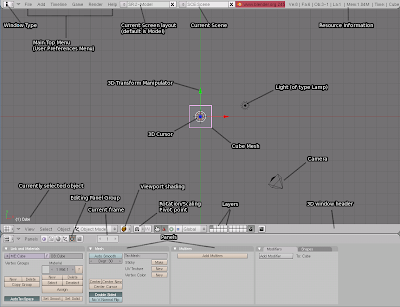Grab
The first operation we will see is the grab operation. It allows us to move a mesh in object mode, or a vertex/edge/face in edit mode.
- Object mode: Select an object and press "g". The object will enter in grab mode, and can be moved by moving the mouse around the 3D view window.
- Edit mode: Select a vertex/edge/face and press "g". The selected item will enter in grab mode, and only that vertex/edge/face will be moved, modifying the surrounding edges and faces.
- In both modes, press left mouse button (or enter) to accept the new position and exit grab mode, or right mouse button (or escape) to exit grab mode without saving changes.
- Select an element in object or edit mode.
- Press "g" to enter grab mode.
- Press "x" to force the grab mode along the X Axis.
- Move the mouse around to see how the object moves.
After the axis key, you can also enter a number to move the object by an exact amount of units.
Scale
The second operation we will see is the scale operation. It allows us to resize a mesh in object mode, or a vertex/edge/face in edit mode, taking as reference the current cursor position (if you don't change it, it will be the "middle" of the object). This works in a very similar way than the grab operation.
- Free scale: Select element, press "s" key to enter scale mode, and move the mouse around to see the scaling effect.
- Fixed axis scale: Select element, press "s" key to enter scale mode, press an axis key ("x", "y" or "z"), and move the mouse along the axis to see the scaling effect.
- Fixed axis and amount scale: Select element, press "s" key to enter scale mode, press an axis key ("x", "y" or "z"), and enter a number to scale the element along the selected axis for the selected amount.
- To exit scale mode, press left mouse button (or enter) to accept changes, or press right mouse button (or escape) to cancel changes.
The third and last operation we will see is the rotate operation. It allows us to rotate a mesh in object mode, or a vertex/edge/face in edit mode, around the current cursor position (if you don't change it, it will be the "middle" of the object). This works in a very similar way than the grab and scale operations.
- Free rotate: Select element, press "r" key to enter rotate mode, and move the mouse around to see the rotation effect.
- Fixed axis rotate: Select element, press "r" key to enter rotate mode, press an axis key ("x", "y" or "z"), and move the mouse around to see the rotation effect over the selected axis.
- Fixed axis and amount rotate: Select element, press "r" key to enter rotate mode, press an axis key ("x", "y" or "z"), and enter a number of degrees to rotate the element along the selected axis for the selected number of degrees.
- To exit rotate mode, press left mouse button (or enter) to accept changes, or press right mouse button (or escape) to cancel changes.













